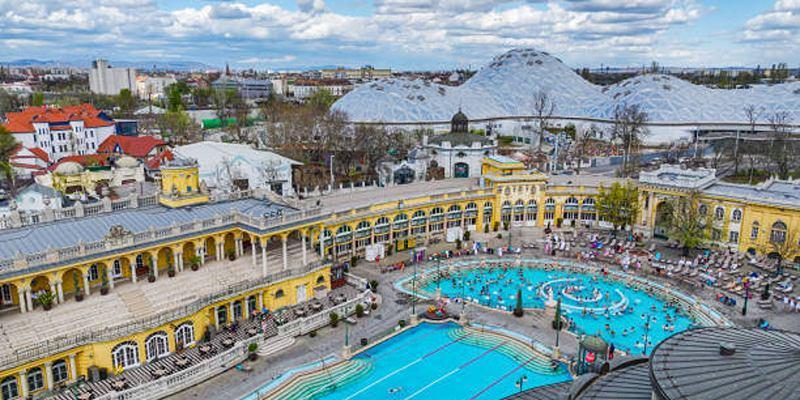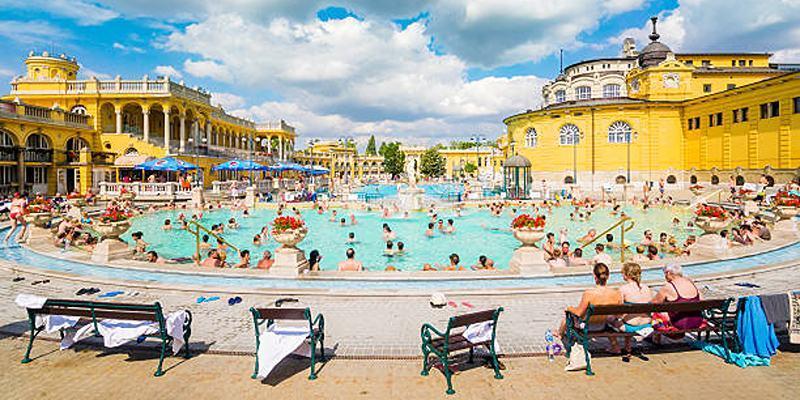Budapest, often called the "City of Spas," is renowned for its historic and rejuvenating thermal baths. With natural spring-fed waters rich in minerals, these baths offer a unique blend of relaxation, wellness, and culture. From opulent architecture to soothing pools, visiting Budapest’s thermal baths is a must for any traveler seeking serenity and charm.
1. Get to Know Budapest’s Thermal Bath Heritage

Before stepping into the warm waters, it’s important to understand the rich tapestry of history that surrounds Budapest’s bath culture. The city’s thermal spring system supplies healing mineral waters to dozens of bathhouses, many of which have been operating for centuries.
Notable thermal bathhouses include:
- Széchenyi Thermal Bath: Located in City Park, it’s one of the largest spa complexes in Europe, featuring expansive outdoor pools and Neo-Baroque architecture.
- Gellért Baths: Known for its elegant Art Nouveau interiors, mosaic tiles, and glass-roofed pools, it offers a luxurious wellness atmosphere.
- Rudas Baths: Dating back to the Ottoman era, this bath offers a mix of traditional Turkish elements and modern rooftop thermal pools.
- Király Baths: A lesser-known historical gem, built during the 16th century, retaining much of its original structure.
- Lukács Baths: Popular among locals for both daily visits and therapeutic treatments, with a quieter, more authentic vibe.
These establishments serve more than just leisure; they are woven into the local lifestyle and are often used by residents for weekly wellness routines.
2. Select the Bath That Suits Your Interests
Each bathhouse in Budapest has its own identity and features, which cater to different needs and preferences:
- Looking for a grand, Instagram-worthy setting? Head to Gellért or Széchenyi, where architecture and atmosphere are equally compelling.
- Want an authentic and serene environment? Choose Lukács or Király, where the focus is more on peaceful soaking and traditional ambiance.
- Craving a rooftop experience with views of the Danube? Try Rudas Baths, especially their night bathing sessions.
Understanding what each location offers helps align your expectations and ensures you get the experience you’re after—be it architectural awe, cultural depth, or pure relaxation.
3. Visit During Less Crowded Times
Timing is everything when visiting thermal baths, especially if you're looking to avoid the bustle. These facilities are incredibly popular with both locals and tourists.
To enjoy a more peaceful experience:
- Arrive early in the morning (typically between 6:00 AM – 9:00 AM).
- Choose weekdays, particularly Tuesdays through Thursdays, for fewer crowds.
- Avoid national holidays, festival weeks, or midday on weekends when tourist groups often visit.
Some baths, such as Széchenyi and Gellért, can become quite busy by late morning. Early visits allow for unhurried enjoyment of every pool, sauna, and steam room.
4. Bring All the Right Essentials
While most baths offer rentals for various items, it’s advisable to bring your own to avoid extra charges and ensure comfort:
- Swimsuit (one-piece or modest two-piece is common)
- Flip-flops or non-slip sandals
- Towel and robe (rentals are available but may be limited during busy times)
- Swim cap (mandatory for use in designated lap pools)
- Hair ties for longer hair
- Water bottle (staying hydrated is vital)
- Waterproof bag for damp clothing
Many bathhouses offer private cabins or lockers for changing and storage. A small, lockable pouch for valuables can add extra peace of mind.
5. Familiarize Yourself with the Facilities
Every thermal bath complex is unique in layout, design, and offerings. Upon arrival, check the map or signage to understand the arrangement of pools and services. Key facilities usually include:
- Thermal pools with various temperatures (ranging from 28°C to 40°C)
- Cold plunge pools (often around 16°C)
- Steam rooms and saunas
- Jacuzzis and medicinal water baths
- Rest lounges and sun decks
Some sites also feature lap pools, weight therapy rooms, or spa services like hydrotherapy and mud treatments. Exploring the facility beforehand ensures you don’t miss out on the full experience.
6. Follow Local Bath Etiquette
Thermal bathing in Budapest is a shared cultural activity with long-established norms. Observing etiquette is essential:
- Always shower thoroughly before entering any pool.
- Keep noise to a minimum—conversations should be soft and respectful.
- Avoid splashing or roughhousing.
- Observe signage regarding pool-specific rules, such as required swimwear or swim caps.
- Photography is generally discouraged inside indoor pools unless explicitly permitted.
These spaces are designed for rejuvenation, and observing these guidelines ensures a harmonious environment for all guests.
7. Pace Yourself and Stay Hydrated
Thermal waters can be deeply relaxing, but prolonged exposure can also lead to fatigue. Experts recommend alternating between hot and cold pools to support circulation and vitality.
Helpful tips for pacing yourself:
- Spend no more than 15–20 minutes at a time in high-temperature pools or saunas.
- Take regular breaks in the rest areas or lounges.
- Drink plenty of water before, during, and after your visit.
- Avoid overexerting in lap pools; these are for light activity, not intensive swimming.
If you begin to feel lightheaded or overly warm, exit the pool and cool off with fresh air or a cold shower.
8. Enhance Your Experience with Add-On Services
To take your thermal bath visit to the next level, consider exploring available wellness treatments. Most spas offer an extensive range of services:
- Massage therapy (aromatherapy, Swedish, or Hungarian-style)
- Spa packages with facial care and mud masks
- Weight baths (used in therapeutic contexts)
- Private thermal tubs or VIP cabins
These services usually require booking and may be subject to specific hours. Checking the official website or calling ahead is the best way to secure your spot.
9. Experience the Baths in All Seasons
Budapest’s thermal baths are open year-round, and each season offers something unique:
- Winter: Soaking in steaming water while surrounded by snow is a surreal and peaceful experience.
- Spring/Autumn: Milder temperatures and blooming gardens (especially in City Park near Széchenyi) create a serene environment.
- Summer: Outdoor pools and sun decks become lively with visitors enjoying both heat and hydrotherapy.
Regardless of the season, the experience remains restorative and visually captivating.
10. Set Aside Enough Time to Relax Fully
Visiting a thermal bath isn’t just a quick dip—it’s a wellness ritual. To truly benefit:
- Allocate at least 2–3 hours for your visit.
- Avoid scheduling other strenuous activities immediately afterward.
- Plan for transition time—changing, resting, and navigating the space.
Many travelers agree that their most fulfilling spa visits were the ones where they slowed down and soaked in the moment—literally and metaphorically.
11. Take Advantage of Budget-Friendly Passes
If you plan to visit multiple spas during your stay or return to the same one multiple times, ask about:
- Multi-day access passes
- Spa combination tickets (offering massage and entry together)
- Discounts for early entry or late access
- Tourist cards that include spa access among their benefits
This can lead to significant savings, especially if you’re traveling with a group or family.
12. Learn From Locals and Reviews

Budapest residents treat thermal bathing as a part of daily life. Observing locals can provide practical insights:
- Best pools to start with
- Proper order of sauna, hot bath, and cold plunge
- Quiet corners for peaceful soaking
- When the pools are at their cleanest and warmest
Online forums, travel blogs, and recent reviews can also offer helpful, real-time insights into temporary closures, staff recommendations, and changing facilities.
Conclusion:
From majestic architecture to mineral-rich water, every element of Budapest’s thermal baths is designed to calm the body and refresh the mind. These spaces are not just historic landmarks—they are wellness destinations in their own right. Whether you’re lounging in the golden glow of Széchenyi’s outdoor pools or meditating in the silent steam chambers of Rudas, Budapest’s baths offer a uniquely serene and memorable experience.












